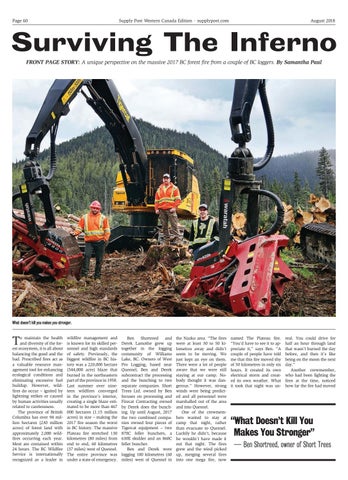Page 60
Supply Post Western Canada Edition · supplypost.com
August 2018
Surviving The Inferno FRONT PAGE STORY: A unique perspective on the massive 2017 BC forest fire from a couple of BC loggers. By Samantha Paul
What doesn’t kill you makes you stronger.
T
o maintain the health and diversity of the forest ecosystem, it is all about balancing the good and the bad. Prescribed fires act as a valuable resource management tool for enhancing ecological conditions and eliminating excessive fuel buildup. However, wildfires do occur – ignited by lightning strikes or caused by human activities usually related to carelessness. The province of British Columbia has over 94 million hectares (230 million acres) of forest land with approximately 2,000 wildfires occurring each year. Most are contained within 24 hours. The BC Wildfire Service is internationally recognized as a leader in
wildfire management and is known for its skilled personnel and high standards of safety. Previously, the biggest wildfire in BC history was a 220,000 hectare (544,000 acre) blaze that burned in the northeastern part of the province in 1958. Last summer over nineteen wildfires converged in the province’s interior, creating a single blaze estimated to be more than 467 000 hectares (1.15 million acres) in size – making the 2017 fire season the worst in BC history. The massive Plateau fire stretched 130 kilometres (80 miles) from end to end, 60 kilometres (37 miles) west of Quesnel. The entire province was under a state of emergency.
Ben Shortreed and Derek Lamothe grew up together in the logging community of Williams Lake, BC. Owners of West Pro Logging, based near Quesnel, Ben and Derek subcontract the processing and the bunching to two separate companies. Short Trees Ltd. owned by Ben focuses on processing and Firecat Contracting owned by Derek does the bunching. Up until August, 2017 the two combined companies owned four pieces of Tigercat equipment – two 870C feller bunchers, a 630E skidder and an 860C feller buncher. Ben and Derek were logging 100 kilometres (60 miles) west of Quesnel in
the Nazko area. “The fires were at least 30 to 50 kilometres away and didn’t seem to be moving. We just kept an eye on them. There were a lot of people aware that we were still staying at our camp. Nobody thought it was dangerous.” However, strong winds were being predicted and all personnel were marshalled out of the area and into Quesnel. One of the crewmembers wanted to stay at camp that night, rather than evacuate to Quesnel. Luckily he didn’t, because he wouldn’t have made it out that night. The fires grew and the wind picked up, merging several fires into one mega fire, now
named The Plateau fire. “You’d have to see it to appreciate it,” says Ben. “A couple of people have told me that this fire moved shy of 50 kilometres in only six hours. It created its own electrical storm and created its own weather. What it took that night was un-
real. You could drive for half an hour through land that wasn’t burned the day before, and then it’s like being on the moon the next day.” Another crewmember, who had been fighting the fires at the time, noticed how far the fire had moved
“What Doesn’t Kill You Makes You Stronger” — Ben Shortreed, owner of Short Trees


